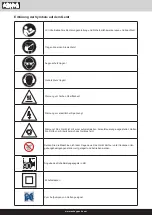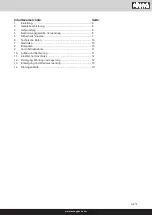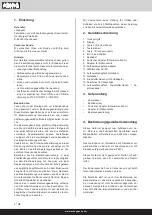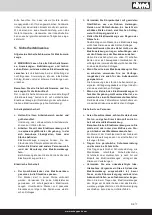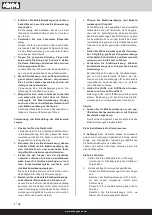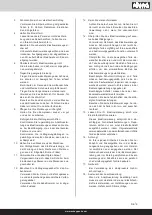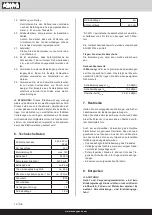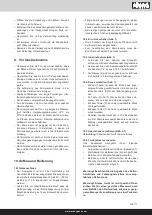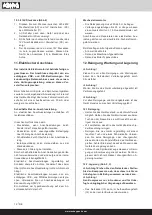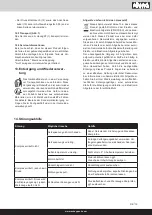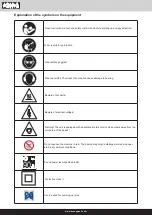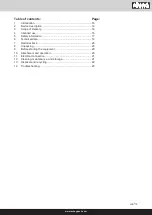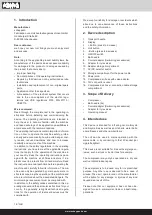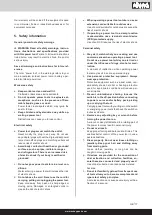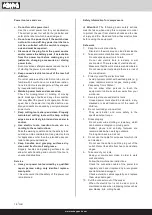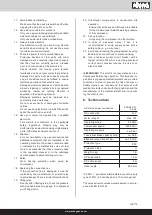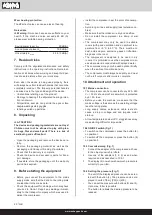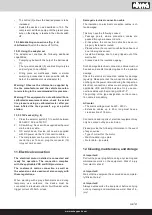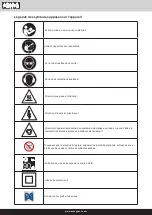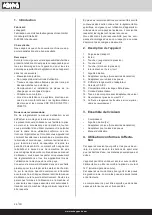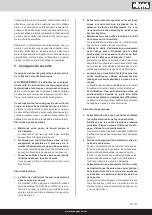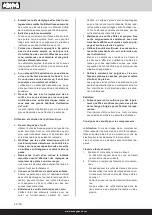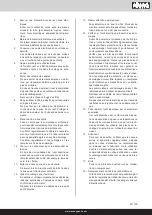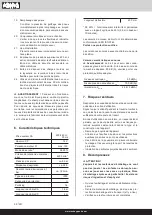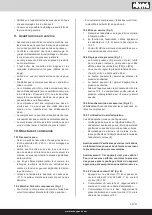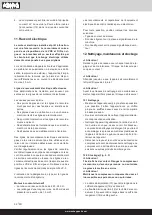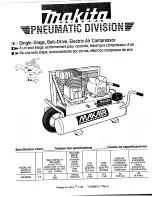
www.scheppach.com
18 | GB
Safety information for compressors
m
Attention!
The following basic safety actions
must be taken when using this compressor in order
to protect the user from electric shocks and the risk
of injury and fi re. Read and follow these instructions
before using the equipment.
Safe work
1.
Keep the work area orderly
-
Disorder in the work area can lead to accidents.
2.
Take environmental influences into account
-
Do not expose power tools to rain.
-
Do not use electric tools in a damp or wet
environment. There is a risk of electric shock!
-
Make sure that the work area is well-illuminated.
-
Do not use power tools where there is a risk of
fire or explosion.
3.
Protect yourself from electric shock
-
Avoid physical contact with earthed parts (e. g.
pipes, radiators, electric ranges, cooling units).
4.
Keep away from children!
-
Do not allow other persons to touch the
equipment or cable, keep them away from your
work area.
5.
Securely store unused electric tools
-
Unused power tools should be stored in a dry,
elevated or closed location out of the reach of
children.
6.
Do not overload your power tool
-
They work better and more safely in the
specified output range.
7.
Dress properly
-
Do not wear wide clothing or jewellery, which
can become entangled in moving parts.
-
Rubber gloves and anti-slip footwear are
recommended when working outdoors.
-
Tie long hair back in a hair net.
8. Do not use the cable for purposes for which it is
not intended
-
Do not use the cable to pull the plug out of the
outlet. Protect the cable from heat, oil and sharp
edges.
9.
Take care of your tools
-
Keep your compressor clean in order to work
well and safely.
-
Follow the maintenance instructions.
-
Check the connection cable of the power tool
regularly and have it replaced by a recognised
specialist when damaged.
-
Check extension cables regularly and replace
them when damaged.
10. Pull the connector out of the socket
-
When the electric tool is not in use or prior to
maintenance and when replacing tools such as
saw blades, bits, milling heads.
Power tool use and care
a.
Do not force the power tool.
Use the correct power tool for your application.
The correct power tool will do the job better and
safer at the rate for which it was designed.
b.
Do not use the power tool if the switch does
not turn it on and off. Any power tool that can
-
not be controlled with the switch is danger-
ous and must be repaired.
c.
Disconnect the plug from the power source
and/or remove the battery pack, if detachable,
from the power tool before making any ad-
justments, changing accessories, or storing
power tools.
Such preventive safety measures reduce the risk
of starting the power tool accidentally.
d.
Keep unused electric tools out of the reach of
children.
Do not let people use the electric tool who are not
familiar with it or who have not read these instruc-
tions. Electric tools are dangerous if they are used
by inexperienced people.
e.
Maintain power tools and accessories.
Check for misalignment or binding of moving
parts, breakage of parts and any other condition
that may affect the power tool’s operation. If dam
-
aged, have the power tool repaired before use.
Many accidents are caused by poorly maintained
power tools.
f.
Keep cutting tools sharp and clean. Properly
maintained cutting tools with sharp cutting
edges are less likely to bind and are easier to
control.
g.
Use electric tools, insertion tools, etc. ac-
cording to these instructions.
Take the working conditions and the activity to be
carried out into consideration.Using electric tools
for applications other than the intended uses can
lead to dangerous situations.
h.
Keep handles and grasping surfaces dry,
clean and free from oil and grease.
Slippery handles and grasping surfaces do not
allow for safe handling and control of the tool in
unexpected situations.
Service
a.
Have your power tool serviced by a qualified
repair person using only identical replace-
ment parts.
This will ensure that the safety of the power tool
is maintained.

